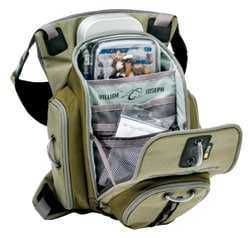
As director of sales for William Joseph, a Utah-based fly-fishing gear and accessories company, Dominick Murphy has noticed something in recent years about the changing behavior of fly-anglers.
“Fly-fishing is such a traditionalist sport,” Murphy says, “and so many guys still cling to their vests. But as the new generation is coming up, they really don’t want anything to do with them. They may want a chest pack or a fanny pack. But they’re not very interested in vests.”
Murphy’s observations stem primarily from the freshwater arena, where vests have adorned the bodies of trout fishermen literally since the sport’s beginnings. There’s good reason for that – they work! But when the weather gets cold and anglers bulk up with extra layers of clothing, Murphy argues, their once-snug vests may suddenly not fit.
“Plus,” he adds, “with all those pockets on a vest, it’s natural to want to fill them up. With a chest pack, it almost forces you to simplify things and only take one fly box, some nippers and retractors, and that’s it. A lot of guys like that.”
Many anglers will always prefer the classic style of the fly-fishing vest, but saltwater enthusiasts in particular know full well the value of packs. Whether small chest packs, midrange hip/fanny/waist packs or spacious backpacks, if you intend to visit and fish some of the areas chronicled in this magazine – especially those that require wading, like the Bahamas or the Seychelles – you’d be wise to invest in several different styles.
Midrange Versatility

Simms Fishing Products, the renowned equipment and apparel maker in Bozeman, Montana, recently consulted a number of top guides in Florida, California, Belize and the Bahamas on the subject of packs, and according to marketing director Diane Bristol, those guides predominantly favored packs worn around the waist. The input led Simms to design the Dry Creek Flats Pack, introduced earlier this year.
“I think from a convenience perspective, it’s really nice to be able to pull the pack around to the front to get into your fly boxes,” Brisol says of the design, noting that engineers paid close attention to minimizing line-snagging areas. “Yet being able to push it back out of the way so it doesn’t interfere with your fishing is very attractive.”
There’s no question that the versatility of waist packs is a huge benefit for fly-anglers. These packs are a decent size and can hold quite a bit of gear. The Flats Pack, for instance, has a water bottle holster and can also tote an extra rod. But it’s their ability to quickly shift positions on the fly (pardon the pun) that’s the biggest draw.

Bill Klyn, marketing director at Patagonia, says that the company’s Hip Chest Pack is its most popular item in the category because, he says, “it holds the perfect amount of gear: your fly box, a point-and-shoot camera, leaders and tippets; you can go minimalist, or you can load it up with multiple pieces of equipment.”
The Hip Chest Pack is unique in that it can be worn either around the waist or on the chest area. Likewise, a smaller Patagonia pack appropriately named Double Haul features modular components that can be worn together or separately around the waist, shoulder or neck.
Riding High and Dry
Wearing packs higher on the body may not facilitate as much flexibility as on the waist, but it offers other advantages. When wading, a high-riding pack allows an angler to venture into deeper water without the worry of submersing the pack and potentially ruining valuable gear. Trudging through waist-deep water to reach a shallow flat is a common thing, and if your pack is tucked high on your chest – or your back – it can be a real lifesaver.
For anglers who anticipate extended periods out of the boat and in the water, backpacks are often the way to go. Out of the way and safe from twisting fly lines, they afford terrific carrying capacity for any number of items (even lunch) and offer fly-anglers a balanced, stable platform to support the weight.

Popular fly gear manufacturers such as Orvis, Fishpond, L.L. Bean, Clear Creek and others offer a wide variety of packs, including those that are completely waterproof. And while William Joseph’s Mag Series packs aren’t guaranteed to keep out water entirely, they seal very nicely and are all but waterproof.
More importantly, though, they incorporate what anglers truly appreciate in packs: innovation. Using a magnetic sealing system instead of zippers, the packs were originally designed for hunters who demanded absolute silence when accessing their camo packs while stalking game.
“At the same time, we were looking for ways to better prevent zipper corrosion for anglers who didn’t keep their packs clean,” remembers Murphy. “One of our designers brought up the magnetic stuff we’d been working on in our hunting line. Suddenly, a light went off – it was a no-brainer.”
Whatever style of pack you decide on, having one’s just that: a no-brainer.









